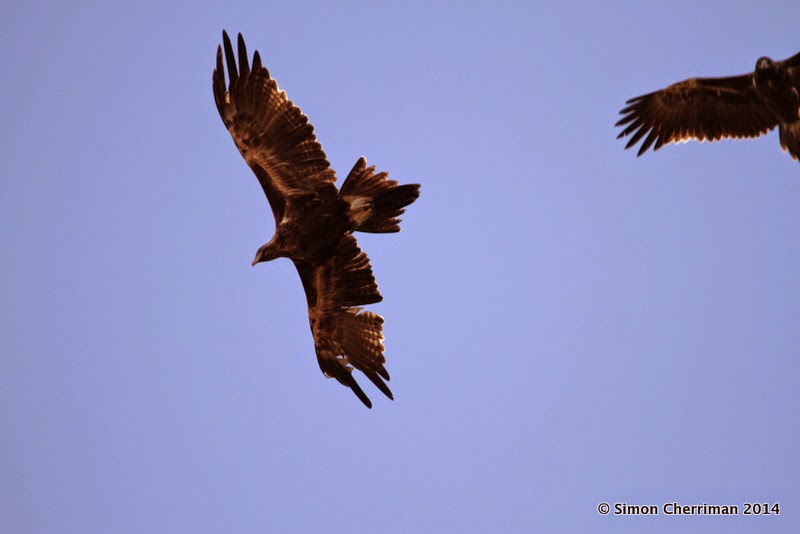
This website has been set up as part of a community education project which allows YOU to follow the movements of Wallu, the first ever Wedge-tailed Eagle to be satellite tracked, and other eagles subsequently satellite-tagged in Western Australia. This exciting and pioneering study, which now forms part of Simon Cherriman's PhD project, aims to shed light on aspects of a unique Australian eagles' ecology which have never before been researched.
Tuesday 25 November 2014
On the Wing
Jarrkanpa has now learned to fly - but only just! Today is the first day we have recorded satellite fixes away from his nest, indicating his first (albeit very small) movements. It is now one week since we satellite-tagged him, and based on an age estimate calculated when he was banded, Jarrkanpa has flown the nest at the age of approximately 90 days.
Can you imagine the feeling of making your first flight, lifting up above the tree-tops, floating on the wind, and getting an even greater perspective on the wetland at the doorstep of your nest? It must be pretty amazing!
We know juvenile eagles' first movements tend to mirror those of their parents very closely, based on field studies of wedge-tails, and from Kuyurnpa's post-fledging movements last year as tracked by satellite (although for this study we only have a sample size of n=1!). So based on this, I expect that tracking Jarrkanpa's progress should reveal approximately where his parents' home range extends to. As today is the 'official' fledging date, I've decided to make a prediction of the size of this range, using the simple map below (click to enlarge). This is based on the proximity of neighbouring nests which I know have been active in 2014.
You might recognise the wetland shown in this map - it is the same one covered by much of Wallu and Wurru's home range. The nests of their two 'southern neighbours' are shown at the bottom left of the map - N62 and N72. Jarrkanpa's parents' neighbours' most recently active nest is N44, to the east. We'll see over the next few weeks how accurate this prediction is. Watch this space!
Tuesday 18 November 2014
Jarrkanpa
Meet the newest member of our satellite-tracked eagle family, a beautiful juvenile Wedge-tailed Eagle called 'Jarrkanpa'. This word comes from the Martu language and means 'young boy', and I decided it would be a fitting name for a ~10 week old male eagle.
Today Jarrkanpa was removed from his nest and fitted with a solar PTT, making him the fourth Lorna Glen eagle to be tracked with satellite technology. But it wasn't the first time I'd handled him. Just over a month earlier, I was nest-searching the edge of Lindsay Gordon Lagoon with my Mum in tow as a volunteer, when I stumbled upon a brand new eagle nest in a previously unrecorded territory. This nest housed one chick, which, when I scaled to the top of its nest tree, greeted me with open wings! (Not in the welcoming way that this saying normally implies though - opening wings and a gaping mouth are signs of a threat display that many nestling raptors exhibit, making themselves appear larger and more threatening, useful for warding off would-be predators).
This photo shows Jarrkanpa at about 5 weeks of age on the day of discovery. You can also see the range of prey animals, including a Dinner Plate Turtle (Chelodina steindachneri), that share the nest cavity with him. A couple of weeks later I climbed this nest again and removed the chick, which was fitted with metal leg bands - this is part of our research to gather further information on the dispersal and survival of juveniles. A photo of him having the bands fitted is shown in the fifth photo down of the 'Cute Chicks' blog post, which also shows a picture of me at the nest (second photo down).
Today, as Neil and I approached the nest, this is what Jarrkanpa looked like:
As these pictures show, the growth rate of young eagles is incredibly swift; this is something that has never ceased to amaze me. Once safely removed from his nest, Jarrkanpa was placed on a soft sheet on the ground and blinded with a falconry hood. Neil held the bird in position as I fitted the transmitter, which went on very smoothly as the harness had been pre-made.
 |
| A solar PTT being fitted to Jarrkanpa's back with a specially designed Teflon harness. |
Subscribe to:
Posts (Atom)





